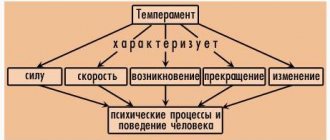All people are different. Individual psychological characteristics of a person determine the uniqueness of each person. Research in the field of differential psychology is devoted to the study of the uniqueness of people. The achievements of this science explain why some people strive to be leaders, while others feel more comfortable in the role of performers; why one person is burdened by noisy companies, while for another, loneliness seems unbearable.
All people are different
Despite the fact that people have the same brain structure, their nervous system is capable of inhibition and excitation, there are still no two completely identical men or women. They are distinguished by individual psychological properties of the individual.
Manifestation of individual psychological characteristics
Unique psychological characteristics of the individual are manifested in human behavior and activity. They are expressed:
- In the speed of work;
- The ability to control your emotional reactions;
- In sociability or isolation;
- In the tendency to defend one’s point of view, to take initiative;
- In the severity of anxiety.
Attention! The main components that determine the uniqueness of a person are temperament, character and abilities.
What kind of temperament is there?
Psychology of human personality
Temperament is an innate component of personality structure. It is customary to distinguish 4 types of temperament:
- Choleric is an impetuous, emotional person. His feelings flare up quickly, then fade away just as quickly. The impulsiveness of choleric individuals is manifested in speech, lively facial expressions, and sweeping gestures. Such people are often conflict-prone, do not know how to compromise and build constructive relationships with others.
- A melancholic person is an extremely sensitive person who is very easily upset. Such people have low resistance to stress and experience failures painfully and for a long time.
- A sanguine person is a cheerful, merry fellow who takes life’s troubles lightly and does not worry about trifles. It is extremely important for him to get different experiences, otherwise he will get bored. The feelings of such people are superficial, and their contacts are numerous.
- A phlegmatic person is a slow, thoughtful person. He has a balanced character and it is almost impossible to anger him. His facial expressions are scanty, and the emotions he experiences are not externally manifested.
Individuality
Temperament properties determine such personality traits and characteristics of a person as:
- Sensitivity (some people are resistant to pressure from others, while others are vulnerable);
- Susceptibility to criticism and destructive behavior of others;
- Cognitive activity, energy, efficiency (there are many obstacles on the way to achieving success, some people easily cope with difficulties, while others fall into despair and refuse to carry out their plans);
- Ability to concentrate in any conditions;
- Relative balance in the processes of the nervous system, which ensures successful interaction with people;
- Speed of mental processes (it is expressed in intelligence, speed of successful memorization of information, rate of speech, speed of writing, walking);
- Extroversion (for such people, communication and numerous contacts with different people are a necessary condition for good health);
- Introversion (a person’s focus on his own inner world provides him with a comfortable stay alone);
- The ability to quickly adapt to a new environment, changing conditions (this quality is professionally important for professions such as investigator, psychologist, doctor);
- Personal flexibility in communicating with people, the ability to find a common language with almost any person;
- Rigidity, conservatism, desire to follow stereotypes.
The type of temperament determines not only a unique set of personal qualities, but also a person’s character.
Additional Information. The names of temperament types invented by Hippocrates have survived to this day. However, this individual quality is now determined not by the proportional distribution of fluids in the body, but by neuropsychological characteristics.
Temperament
The natural prerequisite for individual differences is the characteristics of the nervous system and, first of all, temperament. This term itself, translated from Latin, means “a mixture of elements.” Indeed, temperament is a complex of human qualities. Their various combinations give rise to a diversity of mental activity of people, which is manifested in four main types of temperament.
Types of temperament according to Hippocrates
For the first time, different types of temperament were described by the ancient Greek physician and thinker Hippocrates. He believed that the difference in people's behavior was due to the predominant fluid in their body.
- Sangva - blood gives a person strength, activity, perseverance in achieving goals, sociability and the qualities of a warrior and leader.
- Phlegm (mucus) manifests itself in calmness, slowness and equanimity.
- Holi (bile) makes a person active, even fussy, subject to frequent mood swings and sociable to the point of obsessiveness.
- Melan Holi (black bile) creates gloom, a mood of decline and indecision; people in whom this fluid predominates are sullen losers.
The types of temperament described by the ancient Greek scientist (sanguine, phlegmatic, melancholic and choleric) are still the most popular, although, of course, adjustments have been made to their characteristics. And now no one connects the characteristics of temperament with the prevailing fluid in the body.
Temperament in modern psychology
In fact, temperament is a dynamic characteristic of the psyche, and the difference in its types is associated with the mobility and strength of two main nervous processes - excitation and inhibition. This connection was discovered and described by the Russian physiologist I. P. Pavlov. He proposed his own classification of temperaments, which basically coincides with the Hippocratic one.
A sanguine person is characterized by high speed and strength of nervous processes, as well as a balance of excitation and inhibition. This makes sanguine people active, but without fussiness. They have high performance and a stable mood with quite bright and strong emotions. They are sociable, but picky in choosing friends and pragmatic. Business comes first for them.
A phlegmatic person, with the strength of both excitation and inhibition, is characterized by a low speed of nervous processes with a predominance of inhibition, that is, inertia. This is, in the literal sense of the word, a braking type. Phlegmatic people do not like changes in activity; they are unemotional and uncommunicative. They are slow-witted, but persistent workers.
Cholerics are characterized by high speed and strength of nervous processes, but their excessive mobility and instability. These are very active people with changeable moods, they have many friends, but they themselves are fickle and cannot do one thing for a long time.
Melancholic people are characterized by weakness of both the processes of excitation and inhibition, so their mood changes are not pronounced, and it seems that they are constantly in a state of despondency.
Properties of temperament
These types are not found in their pure form, because temperament is a complex combination of properties and qualities, and it affects all areas of the psyche. For the convenience of studying individual psychological characteristics, several of the most important characteristics that make up temperament are identified.
- Sensitivity is the sensitivity of the nervous system to stimuli.
- Activity – the degree of performance and the ability to maintain a state of excitement.
- The pace of reactions or the speed of mental processes is manifested in the speed of changes in mood, speech, thinking, etc.
- Extraversion and introversion - the level of sociability, communicative openness or isolation.
- Plasticity – ease of changing activities and rapid adaptation to changing conditions.
- Rigidity – resistance to change, loyalty to habits, stubbornness.
Temperament is largely determined by congenital factors and remains virtually unchanged throughout life. True, some of the most striking features in youth can be smoothed out, disguised and adapted to the environment with age.
Character and its classification
Personality qualities - what is it in psychology, characteristics
Character consists of stable traits that explain the behavior and characteristics of a person’s activities. The typology of a person’s character is manifested in his work, communication with people, and handwriting.
Manifestation of character in communication
In psychology, there are several scientific approaches to understanding character:
- Constitutional biological approach. The founder of this concept is E. Kretschmer. According to his views, character is a combined combination of a person’s physique and temperament.
- Psychoanalytic approach. This characterological theory was developed by the masters of psychoanalysis Z. Freud, K.G. Jung and A. Adler. They explained manifestations of character by the presence of unconscious drives in a person.
- Ideological approach. The author of this concept is Robeck, who believed that character is formed as a result of the fact that a person subordinates his desires to the established rules and norms of society. In addition, Robek believed that the social position of an individual largely determines his characterological traits.
While studying character structure, B.G. Ananyev identified in it such components as personality orientation, level of development of communication skills, habits, and features of the emotional-volitional sphere.
N.D. Levitov believed that character is formed on the basis of a person’s attitude to society and other people, to himself and his activities, things.
The similarity of different approaches is seen in the fact that all researchers confidently stated that character depends on a person’s living conditions and his temperament. The basis of character is made up of stable traits that a person can accept and be aware of, or may deny or not be aware of.
Attention! Unlike the type of temperament, character is not an innate property of a person; it is formed in the process of life.
Character
Temperament is the biological basis of another individual-personal property - character.
Character as a biosocial personality make-up
Being a member of society, from the moment of birth a person interacts with other people, learns norms of behavior, and absorbs culture and traditions. As a result, each personality is a unique fusion of biological and social, and character formation occurs in the interaction of these two principles. Therefore, in the same environment, people develop different characters. They are different even among twins, who have very similar biological backgrounds.
It's all about experience. From the moment of birth, we find ourselves in situations to which we react differently, not only depending on our temperamental traits, but also on external circumstances. As a result, we accumulate diverse, but absolutely unique experience, which influences the formation of character no less, and most likely more than the properties of physiology and the nervous system.
Character is a set of characteristics and personality traits that manifest themselves in all spheres of life and leave an imprint on communication with other people, interests, nature of activity, etc. It is not without reason that the term “character” from ancient Greek can be translated as a distinctive feature, seal, sign.
Character traits are quite stable; they are formed in childhood and are a kind of calling card of a person. But still, this personality trait is more changeable than temperament, since its content is influenced by life experience. And often, when we meet a person after several years of separation, we are surprised to notice changes in his character.
Character is a complex formation that has a complex structure. Therefore, there are many typologies or sets of basic traits, which are described by different psychologists.
Trait theory
The English psychologist G. Allport, one of the authors of the theory of traits, believed that each person is a unique and inimitable combination of individual character properties or dispositions (traits). By disposition he understood a stable feature of behavior, the individual’s readiness to behave in a certain way in a given situation. That is, character always manifests itself in behavior or activity, and in order to get to know a person, you need to interact with him, see what he is like in business.
There are central dispositions or traits that determine the entire mental appearance of a person, and they immediately catch the eye. Some are obvious workaholics, while others seek to avoid hard work. One is a cheerful, cheerful joker, and the other is always dissatisfied with everything and complains about everything. Some are bold to the point of recklessness, while others are cautious and indecisive. These are all central dispositions; we call them first when we are asked to characterize a person.
Along with the central ones, there are many secondary features. They are not immediately noticeable and require more time to recognize. Secondary ones, for example, include interests, hobbies, clothing preferences, tastes, etc.
Allport also identifies general and individual features. Being a part of society, a person from birth acquires the qualities inherent in most people from his environment, for example, what we call national character. Italians and Latin Americans are easily excitable and emotional, Norwegians and Swedes, on the contrary, are very calm, reasonable and slow, and the Japanese are characterized by contemplation and restraint.
Individual character traits are what distinguishes a person from other people. The more strongly they are expressed, the more vivid the individuality of the subject. However, if individual traits contradict the general ones, then society can apply social sanctions to such a person, express censure, for example.
Based on the theory of traits by G. Allport, methods for psychological diagnostics of personality were created, for example, factor analysis, tests by G. Eysenck, R. Cattell, etc.
Character Structure
Due to the complexity of this property and the diversity of its manifestations, there are many different classifications of character traits. So, depending on the sphere of the psyche, which plays an important role in human behavior, the following groups of traits are distinguished:
- Emotional, associated with the characteristics of the sphere of emotions and feelings: cheerfulness or gloominess, emotional excitability or coldness, etc.
- Strong-willed: decisiveness and indecisiveness, perseverance, perseverance, independence, self-reliance, etc.
- Moral: honesty or deceit, kindness and cruelty, responsiveness, courage, etc.
- Intellectual: curiosity, resourcefulness, intelligence, thoughtfulness, etc.
You can often hear the expression “a weak-willed person.” What is this? The characteristics of a person’s character are manifested not only in the combination of traits, but also in the strength of their expression. There are people who, due to a weakness of the nervous system or due to problems in their upbringing, have an unstable character. Some of his features are weakly expressed, especially problems are observed in the volitional sphere. Such people are called weak-willed.
Concept of abilities
Psychological trainings for adults
Abilities are special personality properties that allow a person to achieve success in a particular type of activity. Abilities are formed on the basis of natural inclinations. Features of the functioning of the brain, the degree of sensitivity of the analyzers are the main inclinations of the development of abilities.
Unique ability
The level of development of a person’s abilities determines the success of a particular activity. In school classes, the teacher divides students into weak and strong based on the level of development of abilities. In a production team, the level of development of abilities determines the speed of advancement up the career ladder. In the sports section, the coach, based on developing the abilities of young athletes, assembles a team to participate in competitions.
Interesting. Having different levels of development of abilities, people use different ways to achieve goals and methods of solving problems. Through abilities, a person can transfer acquired skills from one area of application to another, using proven tools for various practical tasks.
General and special abilities
Psychophysiologists classify abilities into general and special. General abilities are necessary for the successful mastery of skills such as reading, writing, counting, and self-care skills. Special abilities determine a person’s success in creative activities and sports.
Important! The development of special abilities is based on general abilities. Without mastering general academic skills, a child will not be able to succeed in creative activities.
Feelings and emotions
Feelings and emotions are reflected in the individual typological characteristics of the individual. Their manifestations depend on the strength or weakness of the nervous system, its mobility or inertia, as well as the level of culture and upbringing of a person.
Moral, intellectual and aesthetic
Moral, intellectual and aesthetic feelings, the degree of their expression are determined by the living conditions of a person and his upbringing.
An individual's moral feelings are manifested if he evaluates someone's action from the standpoint of its morality or immorality. In addition, the presence or absence of a person’s sense of duty, goodwill, and empathy indicates the degree of development of his moral side of personality.
People also differ in the degree to which they develop their intellectual senses. These include emotional experiences that arise at the time of mental activity: cognitive interest, thirst for discovering new knowledge, passion for scientific research.
Intellectual feelings
Aesthetic feelings express a person’s ability to notice and appreciate the beautiful in everyday life. People differ from each other in their ability to be surprised, to be moved, to experience joy and sadness, to enjoy the contemplation of nature or to empathize with a literary hero.
Personality types
Today in the specific literature there are many criteria by which personality types are determined.
The typology proposed by E. Kretschmer is now the most popular. It consists of dividing people into three groups depending on their physique.
Picnic people are people who tend to be overweight or slightly overweight, short in stature, but with a large head, wide face and short neck. Their character type corresponds to cyclothymics. They are emotional, sociable, and easily adapt to a variety of conditions.
Athletic people are tall and broad-shouldered people, with well-developed muscles, a resilient skeleton and a powerful chest. They correspond to the ixothymic type of character. These people are powerful and quite practical, calm and unimpressive. Ixothymic people are restrained in their gestures and facial expressions and do not adapt well to changes.
Asthenic people are people who are prone to thinness, their muscles are poorly developed, their chest is flat, their arms and legs are long, and they have an elongated face. Corresponds to the schizothymic character type. Such people are very serious and prone to stubbornness, and have difficulty adapting to change. Characterized by isolation.
K.G. Jung developed a different typology. It is based on the predominant functions of the psyche (thinking, intuition). His classification divides subjects into introverts and extroverts depending on the dominance of the external or internal world.
An extrovert is characterized by directness and openness. Such a person is extremely sociable, active and has many friends, comrades and just acquaintances. Extroverts love to travel and get everything out of life. An extrovert often becomes the initiator of parties; in companies, he becomes their soul. In ordinary life, he focuses only on circumstances, and not on the subjective opinion of others.
An introvert, on the contrary, is characterized by isolation and turning inward. Such a person isolates himself from the environment and carefully analyzes all events. An introvert has a hard time making contact with people, so he has few friends and acquaintances. Introverts prefer solitude to noisy companies. These people have an increased degree of anxiety.
There is also a typology based on the relationship between character and temperament, which divides people into 4 psychotypes.
A choleric person is a rather impetuous, fast, passionate and at the same time unbalanced person. Such people are subject to sudden mood swings and emotional outbursts. Cholerics do not have a balance of nervous processes, so they quickly become exhausted, thoughtlessly wasting their strength.
Phlegmatic people are distinguished by equanimity, unhurriedness, stability of moods and aspirations. Outwardly, they practically do not show emotions and feelings. Such people are quite persistent and persistent in their work, while always remaining balanced and calm. The phlegmatic person compensates for his slowness in work with diligence.
A melancholic person is a very vulnerable person, prone to stable experiences of various events. A melancholic person reacts sharply to any external factors or manifestations. Such people are very impressionable.
A sanguine person is a mobile, active person with a lively character. He is subject to frequent changes of impressions and is characterized by rapid reactions to any events. We can easily relate to the failures or troubles that befell him. When a sanguine person is interested in his work, he will be quite productive.
Also, K. Leonhard identified 12 types, often found in people with neuroses, accentuated characters. And E. Fromm described three social types of characters.
What is the will characterized by?
Willpower determines people’s ability to cope with difficulties and strive for their goals. As an individual typological characteristic, will determines the arbitrariness and self-control of people's behavior.
Willpower determines the presence or absence of such qualities in a person as perseverance, determination, determination, independence, endurance, initiative, courage, discipline, diligence, and organization.
Attention! Will is expressed in the behavioral, cognitive and emotional characteristics of the individual. You can observe the manifestation of will when a person analyzes his actions and bears responsibility for his actions.
Individual psychological characteristics of a person make people different from each other. The uniqueness of each person makes him unique in his activities and communication. It is noteworthy that you can purposefully develop certain aspects of your character in order to attract the right people to you.
Attractive personality
How to write a term paper on speech therapy
07.09.2010 179888
These guidelines are compiled to help students gain an understanding of the content and structure of coursework in speech therapy.
Logopedia of pedagogical science that studies anomalies of speech development with normal hearing, explores the manifestations, nature and mechanisms of speech disorders, develops the scientific basis for overcoming and preventing them means of special training and education.
The subject of speech therapy as a science is speech disorders and the process of training and education of persons with speech disorders.
The object of study is a person suffering from a speech disorder.
The main task of speech therapy as a science is the study, prevention and elimination of various types of speech disorders.
Coursework in speech therapy is a student's scientific and experimental research. This type of educational activity, provided for by the educational and professional program and curriculum, contributes to the acquisition of skills in working with literature, analyzing and summarizing literary sources in order to determine the range of insufficiently studied problems, determining the content and methods of experimental research, processing skills and qualitative analysis of the results obtained. The need to complete coursework in speech therapy is due to the updating of knowledge concerning the content, organization, principles, methods and techniques of speech therapy work.
As a rule, during their studies, students must write two term papers - theoretical and practical.
The first course work should be devoted to the analysis and synthesis of general and specialized literature on the chosen topic. Based on this analysis, it is necessary to justify and develop a method of ascertaining (diagnostic) experiment.
In the second course work, it is necessary to provide an analysis of the results obtained during the ascertaining experiment, as well as determine the directions and content of speech therapy work, and select adequate methods and techniques of correction.
So, let’s present the general requirements for the content and design of coursework in speech therapy.
The initial and most important stage of working on a course project is the choice of a topic, which is either proposed by the supervisor or chosen by the student independently from a list of topics that are consistent with the areas of scientific research of the department.
Each topic can be modified, considered in different aspects, but taking into account a theoretical and practical approach. Having chosen a topic, the student needs to think through in detail its specific content, areas of work, practical material, etc., which should be reflected both in the formulation of the topic and in the further construction of the study. It should be recalled that the chosen topic may not only have a purely theoretical orientation, for example: “Dysarthria. Characteristics of the defect”, “Classification of dysgraphia”, but also take into account the practical significance of the problem under consideration, for example: “Speech therapy work on speech correction for dysarthria”. It should also be taken into account that when formulating a topic, excessive detail should be avoided, for example: “Formation of prosodic components of speech in preschoolers of the sixth year of life attending a preschool institution for children with severe speech impairments.”
The course work includes such mandatory parts as: introduction, three chapters, conclusion, bibliography and appendix.
The text of the term paper begins with the title page . An example of its design can be seen here.
Then the content of the work is given, in which the names of chapters, paragraphs, and sections are formulated in strict accordance with the content of the thesis. An example of its design can be seen here.
In the text, each subsequent chapter and paragraph begins on a new page. At the end of each chapter, the materials are summarized and conclusions are formulated.
The introduction reveals the relevance of the problem under consideration in general and the topic being studied in particular; the problem, subject, object, and purpose of the study are defined. In accordance with the goal and hypothesis, objectives and a set of research methods aimed at achieving the objectives must be defined.
The relevance of the topic lies in reflecting the current level of pedagogical science and practice, meeting the requirements of novelty and usefulness.
When defining the research problem, it is important to indicate what practical tasks it will help to implement in training and educating people with speech pathology.
The object of research is understood as certain aspects of pedagogical reality, perceived through a system of theoretical and practical knowledge. The ultimate goal of any research is to improve this object.
The subject of research is some part, property, element of an object, i.e. the subject of research always indicates a specific aspect of the object that is to be studied and about which the researcher wants to gain new knowledge. An object is a part of an object.
You can give an example of the formulation of the object, subject and problem of research:
– The object of the study is the speech activity of preschool children with phonetic-phonemic speech disorders.
– The subject of the study is the features of intonation speech of children with phonetic-phonemic speech disorders.
– The research problem is to determine effective directions for speech therapy work on the formation of intonation expressiveness of speech in the system of correctional intervention.
The purpose of the study contributes to the specification of the object being studied. The goal of any research is to solve a specific problem. The goal is specified in tasks taking into account the subject of research.
The research objectives are formulated in a certain sequence, which determines the logic of the research. The research objectives are set on the basis of a theoretical analysis of the problem and an assessment of the state of its solution in practice.
The first chapter is an analysis of literary sources, which examines the state of this problem in historical and modern aspects, and presents the most important theoretical principles that formed the basis of the study.
When writing the first chapter, you should pay attention to the fact that the text of the course work must be written in a scientific style. When presenting scientific material, it is necessary to comply with the following requirements:
– Specificity – a review of only those sources that are necessary to disclose only a given topic or solve only a given problem;
– Clarity – which is characterized by semantic coherence and integrity of individual parts of the text;
– Logicality – which provides for a certain structure of presentation of the material;
– Reasoning – evidence of thoughts (why this and not otherwise);
– Precision of wording, excluding ambiguous interpretation of the authors’ statements.
A literary review of the state of the problem being studied should not be reduced to a consistent presentation of literary sources. It should present a generalized description of the literature: highlight the main directions (currents, concepts, points of view), analyze in detail and evaluate the most fundamental works of representatives of these directions.
When writing a work, the student must correctly use literary materials, make references to the authors and sources from which the results of scientific research are borrowed. Failure to provide required references will reduce your coursework grade.
As a rule, in coursework on speech therapy, references to literary sources are formatted as follows: the number of the cited source in the general list of references is placed in square brackets. For example: General speech underdevelopment is a speech pathology in which there is a persistent lag in the formation of all components of the language system: phonetics, vocabulary and grammar [17].
When using quotations, in square brackets, in addition to indicating the source number, the page number from which this excerpt is taken is indicated, for example: Speech rhythm is based on a physiological and intellectual basis, since, firstly, it is directly related to the rhythm of breathing. Secondly, being an element that performs a communicative function, “correlates with meaning, i.e. controlled intellectually” [23, P.40].
However, course work should not be of a purely abstract nature, so you should not abuse the unreasonable abundance of citations. Quoting should be logically justified, convincing and used only when really necessary.
In the second chapter , devoted to experimental research, the organization should be described and the program of the ascertaining experiment should be presented. The survey methodology, as a rule, consists of a description of several series of tasks, with detailed instructions, visual and lexical material, the procedure for completing tasks by experiment participants, and scoring criteria. This chapter also provides a qualitative and quantitative analysis of the results obtained.
When analyzing the results of an experiment, it is necessary to use a scoring system. Examples of various criteria for quantitative and qualitative assessment are presented in the following works:
– Glukhov V.P. Formation of coherent speech in preschool children with general speech underdevelopment. - M.: Arkti, 2002. - 144 p.
– Fotekova T.A. Test methodology for diagnosing oral speech of primary schoolchildren. - M.: Arkti, 2000. - 56 p.
– Levchenko I.Yu. Pathopsychology: Theory and practice. - M.: Academy, 2000. - 232 p.
In order to visually present the results obtained during the experimental study, it is recommended to use tables, graphs, diagrams, etc. Histograms can be used in a variety of ways - columnar, cylindrical, planar, volumetric, etc. An example of the design of tables, figures, and histograms can be found here.
The third chapter provides a rationale for the proposed methods and techniques and reveals the content of the main stages of correctional work.
The conclusion contains a summary of the material presented and the main conclusions formulated by the author.
The bibliography must contain at least 25 sources. The list includes bibliographic information about the sources used in preparing the work. An example of its design can be seen here.
In the application you can present bulky tables or illustrations, examination protocols, observation records, products of activity (drawings, written works of children), notes from speech therapy classes, etc.
The volume of one course work must be at least 30 pages of typewritten text.
In general, coursework in speech therapy is the basis for a future thesis, in which the study of the begun problem can be continued, but from the standpoint of a different approach or a comparative analysis of the disorders being studied in different age categories of people with different types of speech disorders.
The content and format of theses in speech therapy can be found here.
Literature:
1. How to write a term paper on speech therapy: Methodological recommendations. Educational and methodological manual / Comp. Artemova E.E., Tishina L.A. / Ed. Orlova O.S. – M.: MGOPU, 2008. – 35 p.
2. Research work of students in the system of higher professional pedagogical education (specialty 031800 - Speech therapy). Methodological recommendations for completing the thesis / Compiled by. L.V. Lopatina, V.I. Lipakova, G.G. Golubeva. - St. Petersburg: Publishing house of the Russian State Pedagogical University named after. A. I. Herzen, 2002. - 140 p.









